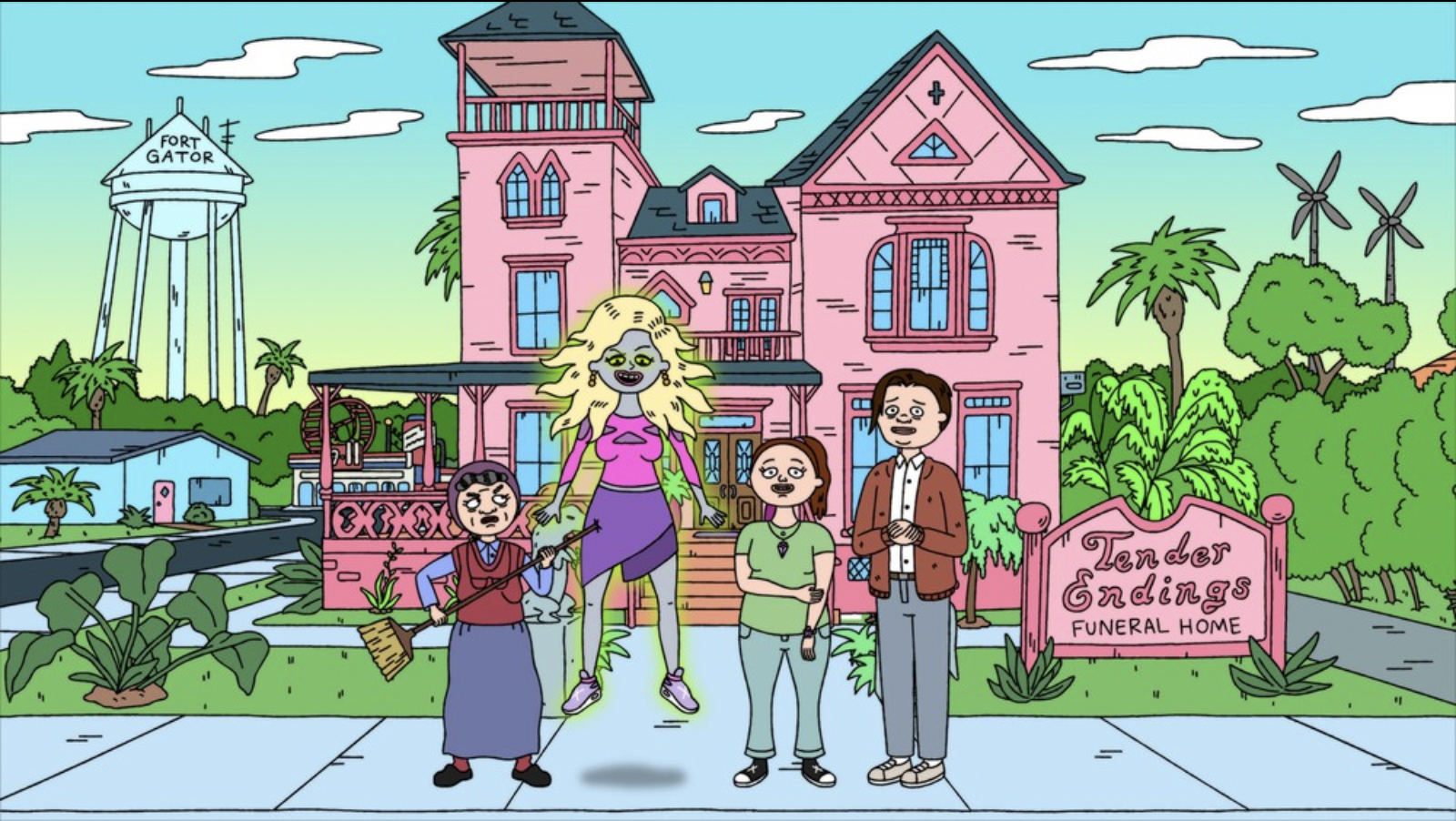Season Review: Teenage Euthanasia Season One
Overview:
Family can sometimes feel like a purgatory of sorts, big that idea is literally put to the test in Adult Swim’s Teenage Euthanasia. Social teen outcast, Annie Fantasy, longs for a life of normalcy, or at the least an existence that can pass off as pedestrian from a passing glance. Unfortunately, Annie’s mother happens to be in a pesky living corpse phase at the moment. The awkward family dynamics are just the tip of the iceberg in Teenage Euthanasia as the Fantasy family try to find peace at their Tender Endings funeral home business in Gator County, Florida. Catharsis, chaos, and crotch beetles are never in short supply in Teenage Euthanasia.
Our Take:
Dysfunctional families have been one of the earliest staples of television and despite the many ways in which the medium has evolved over the years, it remains an archetype that series, especially animated ones, return to because it’s inherently true territory that’s familiar on some level. It’s such an evergreen staple that it’s cycled from being played out to how it’s now once again in vogue on television as it’s returned to some vestige of A new normal. Teenage Euthanasia doesn’t necessarily break new ground in this sense, but it does immediately boast a unique voice that has something to say.
Teenage Euthanasia’s Fantasy family instantly feel at home with the rest of the oddballs and outcasts that populate Adult Swim, but beyond its flashy presentation style lies an honest look at how family can be simultaneously toxic and healing without it needing to pick sides. Behavior is fluid and evolves through the generations of a family and Teenage Euthanasia is at its strongest when each branch of the Fantasy family’s crooked family tree gets a chance to shine. It results in one of the sweetest, strangest, and most sincere animated sitcoms of the season.
Teenage Euthanasia has no lack of absurd situations, but its humor is primarily driven by its cast of heightened characters. Trophy Fantasy (Maria Bamford), the reanimated corpse mother of Annie Fantasy (Jo Firestone) is visibly the strangest of the characters, but there’s a fairly typical family structure that’s present between Trophy, Annie, Baba (Bebe Neuwirth), and Uncle Pete (Tim Robinson). Everyone fits into their roles, with Bamford and Neuwirth giving the most animated of vocal performances.
There’s also a rich roster of guest stars featured throughout the season and each entry has some fun guests, yet ones that never steal too much focus. On a surface level the Fantasy family may feel like stereotypes in some regards, but the series’ wonderfully askew slant on sitcom and family values makes all of this work. This first season also never runs out of creative pairings to experiment with to figure out when each member of the family is at their best. These seven episodes rotate through each conceivable combination and it’s another effective way for the show to quickly find its voice.
Building off of these character relationships and eclectic Fantasy family combinations, the first season of Teenage Euthanasia also finds a lot of variety in its storytelling. It accomplishes a lot in only seven episodes and it feels like a lot of different versions of this show get a chance to shine. Some elements can cover the same ground, but there’s nothing here that trades opportunities for unique character work for an easy laugh. Teenage Euthanasia also doesn’t squander the fact that it’s a half hour series. Each episode’s storylines are layered enough and develop to a degree that they wouldn’t work in Adult Swim’s quarter-hour format. This isn’t a situation of an Adult Swim show that needlessly runs the clock by stretching a thin premise beyond its natural endpoint. It justifies its length.
Teenage Euthanasia also often benefits from how it’s an animated series that accentuates the weirdness of the real world rather than a show that’s set in some fantastical realm or genre pastiche. There’s still no shortage of supernatural and broader elements within Teenage Euthanasia. This is a series where a reanimated corpse who is filled with a colony of beetles is one of the main characters. However, Teenage Euthanasia strangely grounds its unique brand of weirdness early on and very quickly the series establishes a baseline for itself that’s consistent as the series continues.
Additionally, Teenage Euthanasia is set within the Tender Endings funeral home business of the Fantasy family, but it’s refreshing that the show doesn’t confine itself to this workplace prison. This idea is present in the background, but very few episodes are actually driven by it. In quickly getting away from the homebound and occupational material, this first season builds the freedom to explore the rest of Gator County, Florida. The futuristic technology that courses through the series is a beautiful element that never feels the need to explain itself. It just adds more to the series’ distinct flavor.
The same is true about the litany of supernatural elements that consume Trophy’s characters. A good deal of episodes hinge on her supernatural ability to bend the rules of the universe, but it benefits from never losing itself in exposition or a dense mythos. At the same time, Teenage Euthanasia is very episodic in nature and isn’t interested in heavy serialization, yet it does build continuity through its characters and the general Florida weirdness that’s present. A very good sense of Gator County is felt by the end of the season.
Adult Swim’s animated programming can wildly fluctuate from series that pride themselves in their amateurish, lo-fi looks while others thrive on their ambitious and unique art designs. Teenage Euthanasia is an example of the latter and it sports a very distinct, neon color palette that pops off the screen. Augenblick Studios always produces strong work and Teenage Euthanasia is no exception. It’s well within their wheelhouse, but their animation and Abby Jame’s designs mesh so well with the Florida aesthetic. The characters aren’t ugly to look at and frames are often busy with lots of detail going on in the background of scenes. However, it’s still the use of color that stands out more than anything else.
The first season of Teenage Euthanasia is only seven episodes long, but it’s surprisingly economic in its brevity. By the end of this season there’s definitely a stronger grasp on each of these characters than when things began and the world also feels richer and vibrant. The cast feels further along when the season ends, but also that Teenage Euthanasia has only scratched the surface with what they’re capable of in many ways, especially when it comes to characters like Pete. The show’s storytelling only grows more confident the further that it gets away from the Tender Endings funeral home and the series’ general comfort zones.
The season’s final episodes give a good indication of what’s ahead in a hypothetical second season with even more surreal plots like the Gymnast Gregory or “Daddy, It’s Me (Florida Edition)” shenanigans, or any of the weirdness that’s present at Annie’s school. It’s reassuring to already know that Teenage Euthanasia doesn’t need to cling too closely to its premise and that it can generate laughs regardless of what these characters are doing.
Funeral homes are usually not a place that the public likes to frequently visit, yet the first season of Teenage Euthanasia accomplishes the impossible by creating a lovably quirky one that audiences will be eager to return to for another extended visit. This home of death, in Florida in less, couldn’t be full of more life.


























Do we know if Hulu will be the only entity to have the dub, or if it will be on other platforms, too? The show in general is definitely going to be on multiple platforms.